Choosing the Right Mattress Thickness for Bed Frame Compatibility
Selecting the right mattress thickness is crucial for optimal comfort and bed frame compatibility. Standard mattress thickness ranges from 8 to 14 inches, with most high-quality options falling between 10 to 12 inches. This range typically provides a balance of support and comfort for most sleepers.
Mattress thickness can vary based on the type of mattress. All-foam mattresses generally measure 9 to 12 inches thick, while hybrid models often range from 11 to 13 inches. When choosing a mattress, consider factors such as body weight, sleep position, and personal preferences. Thicker mattresses may offer more support for heavier individuals or those who prefer a plush feel.
For parents looking to choose kids' beds, mattress thickness is an important consideration. Children's mattresses are typically thinner, often ranging from 5 to 8 inches, to accommodate growing bodies and ensure safety in bunk beds or themed sleeping arrangements.
Key Takeaways
-
Mattress thickness affects comfort, support, and bed frame compatibility
-
Standard mattresses range from 8 to 14 inches thick
-
Consider body weight, sleep position, and bed type when selecting mattress thickness
Understanding Mattress Thickness and Its Impact on Sleep Quality
Mattress thickness plays a crucial role in determining comfort, support, and overall sleep quality. The right thickness can enhance spinal alignment, pressure relief, and durability.
The Role of Mattress Thickness in Comfort and Support
Mattress thickness directly affects comfort and support levels. Thicker mattresses often provide more cushioning and pressure relief. They typically have multiple layers, including comfort layers and a supportive base layer.
Comfort layers, usually made of memory foam, latex, or other soft materials, contour to the body. The base layer provides essential support and stability. Thicker mattresses can accommodate more of these layers.
A mattress that's too thin may not offer enough cushioning for pressure points. Conversely, an overly thick mattress might lack proper support, especially for heavier individuals.
Matching Mattress Height to Sleep Positions
Different sleep positions require varying levels of mattress thickness for optimal comfort and support.
Side sleepers often benefit from thicker mattresses (10-14 inches) with plush comfort layers. These provide better pressure relief for hips and shoulders.
Back sleepers typically find medium-thick mattresses (10-12 inches) suitable. These offer a balance of support and comfort for spinal alignment.
Stomach sleepers usually prefer thinner mattresses (6-10 inches). Firmer, less thick options help maintain proper spine positioning.
Hybrid mattresses, combining innerspring support with foam layers, can accommodate various sleep positions at different thickness levels.
Importance of Material and Layers for Durability
The materials and layer composition of a mattress significantly impact its durability and longevity.
High-quality materials like latex and high-density foams tend to be more durable. They resist sagging and maintain their shape over time.
Multiple layers in thicker mattresses can enhance durability. A sturdy support core paired with resilient comfort layers helps distribute weight evenly.
Thicker mattresses often have better motion isolation properties. This is particularly beneficial for couples sharing a bed.
The density of foam layers affects durability. Higher-density foams typically last longer and provide consistent support.
Mattress thickness also influences temperature regulation. Thicker mattresses with advanced materials can offer better airflow and cooling properties.
Choosing the Right Mattress Thickness for Specific Bed Types and Personal Needs
Selecting the optimal mattress thickness involves considering bed frame compatibility, body type, and individual health needs. These factors play a crucial role in ensuring comfort and proper support.
Compatibility with Various Bed Frames and Foundations
Platform beds work well with mattresses 6 to 14 inches thick. Adjustable bases require flexible mattresses, typically 8 to 12 inches thick. Bunk beds and trundle beds need thinner mattresses, usually 6 to 8 inches, for safety and functionality.
Standard bed frames can accommodate a range of thicknesses. A mattress thickness chart can help match mattress height to frame type:
-
Low-profile frames: 6-10 inches
-
Standard frames: 10-14 inches
-
High-profile frames: 14-18 inches
Consider the overall bed height when choosing mattress thickness. This includes the combined height of the foundation and mattress.
Mattress Thickness Recommendations for Different Body Types
Body weight significantly influences the ideal mattress thickness:
-
Lightweight sleepers (<130 lbs): 10-12 inches
-
Average sleepers (130-230 lbs): 10-14 inches
-
Heavyweight sleepers (>230 lbs): 12-14 inches or more
Thicker mattresses often provide better support for heavier individuals. They offer enhanced pressure relief and prevent bottoming out. Combination sleepers may benefit from medium-thick mattresses (10-12 inches) for ease of movement.
Extra-thick mattresses (14+ inches) can provide luxury comfort but may be excessive for some sleepers.
Special Considerations for Health Conditions and Sleep Needs
Certain health conditions require specific mattress thicknesses:
-
Back pain: 10-14 inches for adequate support
-
Arthritis: 12-14 inches for easier bed entry/exit
-
Mobility issues: 14-18 inches to facilitate getting in and out of bed
Edge support is crucial for those with limited mobility. Thicker mattresses often provide better edge reinforcement.
Sleep position also influences thickness choice:
-
Side sleepers: 12-14 inches for pressure relief
-
Back sleepers: 10-12 inches for spinal alignment
-
Stomach sleepers: 8-10 inches to prevent excessive sinkage
Consider personal preferences for firmness and comfort when selecting mattress thickness. A balance between support and comfort is key for optimal sleep quality.
Conclusion
Mattress thickness plays a crucial role in bed frame compatibility. Standard mattresses between 8-12 inches work well with most frames. Thicker options may require deep-pocketed sheets and specialized frames. Considering both comfort and frame fit ensures an optimal sleep setup. Measuring the bed frame and consulting manufacturer guidelines helps select the ideal mattress thickness.
Browse by Category

Design Projects
Explore interiors from client work and personal renovations — layered, livable, and always in progress.
read more →
Collaborations
From product launches to styled spaces, discover the brand stories I’ve helped bring to life.
read more →
The Notebook
A growing archive of iconic designers, inspiring artists, and unforgettable design moments.
read more →
Travel by Design
Wander with a designer’s eye — from charming hotels and city guides to visual inspiration abroad.
read more →





